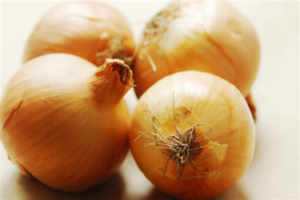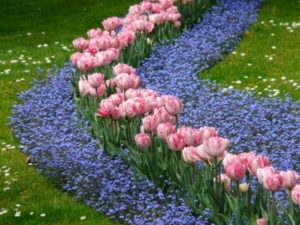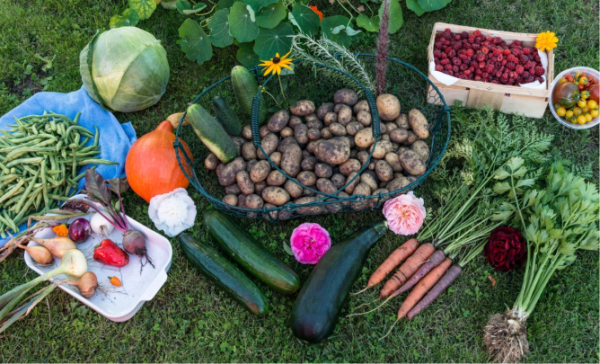
Curious as to how to Start a Vegetable Garden from Scratch?
Starting your own vegetable garden from scratch can be rewarding and exciting at the same time.
Actually, I must admit that nothing tastes better than some nice home-grown vegetables.
However, if you are planning on starting a vegetable garden in a neglected and uncultivated land, this whole thing could be quite daunting.
Sure enough, you will have the image of a beautiful kitchen garden with a nicely planned layout in your mind, but then, where do you start?
This is what I will tell you.
To become that successful gardener that you have always been dreaming about, you will first need to understand what it takes to keep plants vigorous and healthy.
Most gardeners will tell you that all you need to do is buy some plants and stick them to the ground.
Well, I can’t deny this could work out quite well at times.
but it will never be as good as when you have a plan and you take your time to actually think about what you want to plant in your garden.
For that reason, this article will be aimed at giving you a comprehensive guide that will help you start your ideal vegetable garden from scratch.
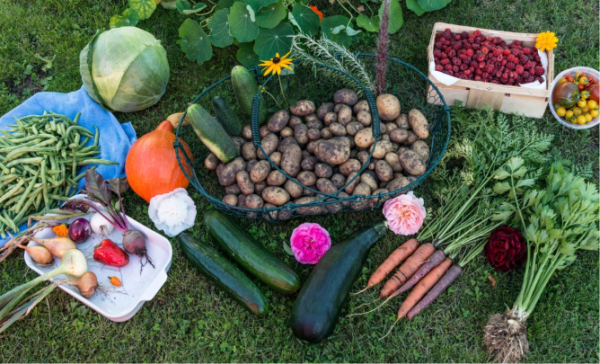
Fresh Vegetables from the Garden
Step 1: Choose The Best Location for Your Vegetable Garden
This is the first and most important step that you need to consider when you want to start your vegetable garden from scratch.
By choosing the right location, it helps you so much with the planning as a first time gardener.
In line with the selection of the location, you need to consider some other factors like the exposure of your garden to direct sunlight as well as the direction of the wind.
⦁ Consider the exposure to direct sunlight
Vegetables are one of the most sensitive plants.
And that being the case, they need at least exposure to direct sunlight for about 6 or 8 hours in a day.
Lack of enough sunlight will only limit the growth of your vegetables, especially with the tomatoes.
Where there is a challenge with exposure to direct sunlight.
There are always so many options that you can incorporate. To improve the situation.
Such include the use mirrors or even white walls to reflect sunlight on to the garden.
This may not be as much sunlight as one the crops will get with direct sunlight. But it makes a big difference still.
More to that, it is always necessary that you consider the effect that structures around your garden like houses and sheds would have on your garden’s exposure to sunlight.
Also, you need to consider if these houses and sheds will lock out the morning sun.
And if so, it’s always a great idea that you look for another suitable location before it’s too late.
More so, you need to consider how long the shade caused by the houses and sheds will last.
In most cases, afternoon shade is okay especially if it’s during the hot summers.
However, the afternoon shade is never a good idea, especially during the cool seasons.
Step 2: Determine the Vegetables to Plant in your Garden
As soon as you pick the ideal spot in your garden to plant your vegetables and you know how much sun your garden will receive.
Feel free to choose the plants to grow. And the choice of plant narrows down to the season and what you need to grow.
We will discuss more of this later in the article.
Step 3: Choose the Ideal Planter
You can grow your vegetables in very many different ways.
In this case: you could consider using either pots, garden beds, wall planters, wooden planters, the raised beds, and vertical gardens.
Step 4: Planting your vegetables
In this step, you first need to prepare your soil then plant the seedlings or seeds in the planters.
Ensure that you water them on a regular basis.
During the planting period, ensure that you turn the soil using a spade so that it loosens and gives room for the roots to grow.
Crop rotation is also very important when growing vegetables like strawberries and kales.
This will discourage the common plant diseases and pests that affect the specific plants.
Step 5: Feed and Care for the Vegetables
Once the vegetable garden is ready, the other important step is feeding the pants with fertilizers.
The best fertilizer to use is organic fertilizers or compost manure.
Also, remember to water your plants all year round.
Top easiest Vegetables to Grow in your Garden
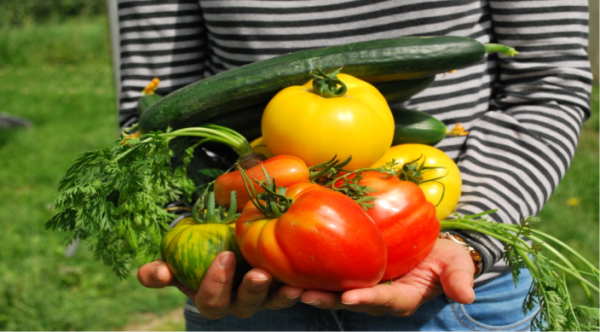
Well, I must agree that growing your own vegetables in your garden is the ideal activity that helps you to lance out indulgence and practicality.
Also, it helps with the convenience especially when you need to prepare salads or a light meal.
In that case, here is a list of the garden vegetable list that you can choose from.
⦁ Basil: this is a common garden vegetable often planted together with tomatoes. This is because the two are known to improve each other’s taste. Also, they taste great when paired up in dishes. Make sure the basil is started from seeds and its grown in the sun with the soil moist.
⦁ Arugula: this is a great vegetable for making salads and it prefers some cool temperatures. In that case, sow the seeds in fall or early spring.
⦁ Beans: beans are best planed in warm soil. Make sure that you don’t soak up the beans forts before planting as this will only make them rot or crack.
⦁ Broccoli: when it comes to broccoli, the homegrown ones definitely have a better taste than the commercially grown. It is a plant that does well in the cool seasons. To minimize the problems with insect infestation, ensure you do crop rotation now and then.
⦁ Cabbage: cabbage does well in the early spring when the soil is soft. It’s so much similar to Brussels in that it needs a lot of moisture and a long growing season to do its best.
⦁ Bok choy: more like cabbage this is used in stir-fries. It does well in moist and cool conditions. Also, this is one garden vegetable that doesn’t mind growing in the shade.
⦁ Beets: these needs quite a large space to grow well. They are best planted in the early spring or in the late summer and with this, you will get summer harvest or fall harvest.
⦁ Carrots: these are very easy to grow with the right conditions. They can however e slow to germinate especially in dry conditions.
⦁ Corn: this requires plenty of soil and space to grow. Corn is pollinated y wind so instead of planting them in one long row, plant them in a lock of at least four rows.
⦁ Eggplant: eggplants are grown the same way you do with tomatoes. Seedlings should be planted in a sunny and warm location and make sure that the soil is moist evenly for them to do well.
⦁ Kales: this does well either as a fall or even spring plant. Harvest kales before the hot seasons start as so much heat makes the leaves become a little bitter. Kales is a good nutrition vegetable.
⦁ Onions: they can take longer to grow especially from seeds, therefore, are mostly grown in sets.
⦁ Tomatoes: the most commonly grown garden vegetables. This is because most people prefer how homegrown tomatoes taste. Make sure that when you choose seedlings, you have researched the source.
⦁ Watermelon: these need a log and hot summer as well as plenty of water to mature. the short season watermelons do the best in a garden vegetable.
⦁ Potatoes: these are drought-resistant crops that could give you a bountiful harvest. Only ensure that you rotate the crops to avoid crop diseases.
Other vegetables to include in your garden are
Zucchini
Turnips
Spinach
Sweet potatoes
Radish
Rutabagas
Okra
Pumpkins and more
How to Grow Vegetables at Home in Pots?
Container vegetable gardening is always an easy way to experience the freshness and flavor of some home grown plants.
This especially applies when living in urban locations where you don’t have your own garden space.
And the good thing is that most vegetables actually do pretty well when grown in containers.
You only need to pick a few right plants and then you can get started on your container vegetable garden.
Materials needed for Preparing your Vegetable Garden Bed
⦁ The Type of Container Needed
Most people always take this as so much of a big deal but the truth is that you’ll probably be worried about this even more than your plants will.
The good thing with most vegetables is that they aren’t fussy about the kind of vegetable garden container they have grown ion.
You only need to pay attention to plants grown in terra cotta pots.
Due to their porous nature, you may need to water the plants grown in there more often.
Also, since the pot is dark in color, it tends to absorb heat and this may make the soil too warn for some garden plants especially during summer.
Lastly, never use vegetable containers that are made of treated wood.
This is because the wood may contain chemicals that may be toxic to the plants when absorbed by the vegetables.
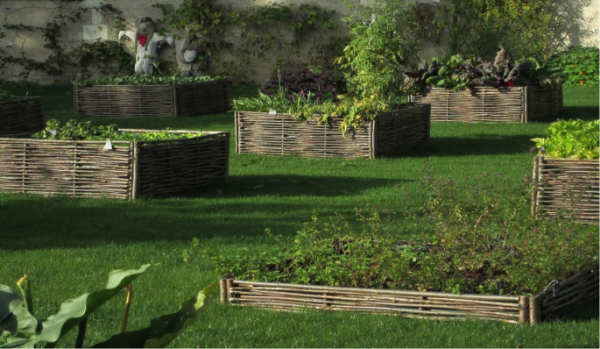
Raised Garden Bed
⦁ The Container Size
This is one of the major things that you need to pay attention to when it comes to container gardens.
The bigger the pot, the better at all times especially if you are a first-time gardener.
Generally, the large pots hold more soil hence they are able to retain moisture for a longer period and this will ease the watering task for you.
In that case, as you choose your container garden, ensure that it’s at least 10 inches wide and 12 inches deep.
Some of the best include the window boxes, large flower pots, half barrels or even a plastic lined bushel basket.
Any 5-gallon bucket works perfectly fine for this task.
All in all, there are some plants that will need particularly larger containers.
Such include tomatoes and vining crops like the cucumbers.
These two will do best in container gardens that are at least 20 inches in diameter.
⦁ The Type of Soil
Plants will rarely be fussy about the kind of pot they are planted in but they do care a lot about the type of potting soil you use.
Basically, any vegetates will do best when grown in organic soil.
In that case, you should consider organic gardening for your plants.
This is because the organic gardens give your vegetables the ideal flavor.
Step by step Procedure for Planting Vegetables in Containers
⦁ Start the Seeds
It’s important that you plant the seeds in your container vegetable garden at the same time that you plant in the garden.
However, this depends a lot with the type of vegetables you want to grow.
At times you can start the seeds directly in the container or even you can grow the transplants to seeds that you can earlier on started indoors.
In other cases, you can consider getting transplants from a suitable garden center in your location.
All in all, when it comes to beans, radishes, spinach, carrots, and corns, the seeds are best sown directly on the container garden.
⦁ Fill Organic Soil in the Pot
When filling your container garden with soil, it’s always important that you leave at least 2-3 inches from the edges of the pot.
This space gives you room to fill in water.
This is regardless of whether you are planting transplants or sowing seeds directly.
Ensure that you thoroughly water container before planting anything. In that case, soak the potting mixture then allow it to sit and drain for a few hours. This gives it time to drain the excess water.
⦁ Add the Plants Then Fertilize
When planting in your vegetable garden, it’s important that you leave at least a space of 3-4 inches between one plant and the other.
Ensure that you follow the instruction given on the package.
Also, not all the plants that you sow germinate.
In that case, always ensure that you plant more than what you need.
You can always thin out the excess.
For the transplants, it’s better when you set them at the same level they were growing in the growing pot.
Also, add some blurry tags that will help with the identification of the plants.
More to that, ensure that you add some organic fertilizer.
This could be before planting, after or both.
Ensure that you don’t over fertilizer the crops as they will only grow too fast, get too soft and their flavor also won’t be as intense.
A month later after planting, you could feed the plants at least once a week with water soluble fertilizer.
Also, ensure that you water the plants gently after planting so that the seeds or transplants settle.
To keep the soil in your container garden from drying out fast, you could mulch with compost, leaf Mold or any other suitable material.
Care Tips for Vegetables grown in Container Gardens.
When it comes to caring for plants grown in a container garden, watering is always the most crucial thing.
in that case, ensure that you inspect the vegetables regularly so that the potting mix doesn’t dry out.
If you easily forget to water the crops, you can consider installing a drip irrigation that will water your crops automatically in case you forget to.
Also, to ensure that your container garden remains fully productive, you should watch out for any weeds as well as any kinds of pests.
Container grown plants are less susceptible to diseases but you still need to watch out for any signs of plant disease on your vegetables.
Any plants that show signs of plant disease should be removed immediately or treated before it spreads out and affects all plants.
Placing the container where there is enough sunlight and good ventilation helps control the infestation of the plants by insects.
The Best Garden Soil Mix
In most cases, it’s best when you use your own topsoil to start your crops.
Buying the aged soil for raised bed can be quite expensive especially if you are filling more than one deck.
But before you get started, you need to first test the ph. level of the soil.
Knowing your soil ph. is essential as you get to create the optimal conditions for your crops.
The soil in the dry regions in most cases is alkaline while the one in rainy regions will be acidic.
Some vegetables like acid soil like potatoes, tomatoes, and blueberries.
However, some crops will sulk when the soil ph. the level is too high or too low. In that case, a Ph. level of .0 or 7.0 is the ideal one.
When you add compost to alkaline or acidic soil, the Ph. buffers and comes closer to neutral.
With acidic soil, you can add some lime; dolomitic lime is the best recommended as it also helps when the soil has some magnesium deficiency.
To lower the acidity of your soil on the other hand you can add peat moss.
⦁ The Simple Soil Mix
This is the ideal soil lend especially if you are filling many large beds or in cases where there is plenty of healthy loam.
You can either screen your topsoil or buy some screened topsoil.
Mix this with an equal portion of screened compost. The compost could contain fish, mushroom, and kitchen waste.
You can discard the top layer of the soil as this may have weed and grass contamination.
Fill your raised beds with this mixture and ensure that you add more compost on a yearly basis. This could be done in the early spring.
⦁ The Luxury Mix
This works well with smaller container gardens.
Also, it could be used in instances where you want your raised bed to start out completely when free from weeds.
In this case, you can start out with 100% materials that are purchased and screened.
With this, your plants will grow in a potting mixture that has none of the dirt that is found in the garden variety of soil.
To make this mix, you will need vermiculite, peat moss and different varieties of compost.
The amount of these components will depend on the size of the planter that you have.
In case you don’t have the vermiculite, coconut coir or perlite works perfectly as a substitute.
These are great water retaining and aerating mediums that will make your smaller container gardens thrive.
This is because the structure and the small nature of the container may create moisture problems as well as compaction.
⦁ The Lasagna Mix Method
This is just what you need for your extra tall garden ends.
These kinds of gardens can be quite intriguing to garden but at the same time very pricey to fill with good soil.
In that case, consider layering grass clippings and leaves on the lower part of the raised garden bed.
They act as good bulk organic matter.
The grass clippings should be added in these layers in order to avoid matting.
You could also include, straw, shredded bark, and wood clippings.
When you finally fill the raised garden beds to 6 or 12 inches, you can now add a compostable barrier like untreated cardboard.
This helps with ensuring that your good soil doesn’t sift down quickly.
Then you can now fill the remaining portion of the raised garden bed with the soil mix of your choice.
After precisely a year, you will realize that the soil has sunk due to decomposition and the settling of grass cuttings that you placed at the lower part.
In this case, you will have plenty of room to add some more fresh compost on the top.
If the containers you are using are too deep, you can instead use an inert filler at the bottom.
Such may include stones, ricks and milk jugs.
The inert filler should, however, be covered by fabric to enable drainage as well as prevent loss of soil before you add the soil mix of your choice.
How Much Soil do you Need?
How much do you really need? You’ve probably thought about this from time to time.
Especially when you need to purchase mulch, soil or any other garden products.
Planters are very good alternatives to the traditional gardens.
However, to get the Best results, you must make sure that your vegetables get enough rooting depth and adequate soil.
The Rooting Depth: most plants have roots that could go to incredible depths.
Most ordinary vegetables grow to root depths of 7 feet, although they contrite them in the top 3 inches of the soil.
In that case, most plants will do well when plated inadequate soil of about 1 inch of well-prepared soil.
The Planter Depth: its ideal if you plant your vegetables in planters that are at least 12 inches deep.
This is Because it will be adequate for the large plants and overly generous for the smaller ones.
The deeper planters will not require much watering.
However, you can choose the planter according to specific plants requirements.
For instance: onions and garlic will grow up to 8 inches while others like carrots could grow up to 10 inches.
The Area of the Planter: it’s always necessary that you consider a wide planting spacing as this is so beneficial to the plants that you have.
However, planters have very limited space and you might have to plant them close together.
In that case, if you are planting your onions in 4 inches by 4 inches’ planter’s then the total surface area needed is 16 square inches.
The Soil Quantity in the Planter: Well, when you get it right with the planter depth as well as the planting area you need, you can now calculate the amount of planter soil you need.
What you simply do is to multiply the surface are y the depth of the planter.
When you get the result, you should then multiply it by the number of plants you intend to plant in your garden.
For instance: let’s say that you want to plant some carrots in a 4 by 4 inches’ space, and a planter that is 7 inches deep.
Each onion that you plant will need at least 16 square inches of the surface of the soil and 112 cubic inches of soil per every carrot.
Therefore, if for instance, you want to grow 10 carrots: what you’ll need is 112×10=1120 cubic inches of soil for the entire planter.
Plant Nutrition
For plants to thrive and be healthy, they need a wide range of nutrients.
In this case, if you are making your own compost, the leftovers of your own food could make a perfect diet for your garden too.
Only that the issue with kitchen waste its limited to what your house majorly consumes.
In that case, it’s advisable that you get at least five different sources for your compost.
This could include the compost from the kitchen as well as four other sources.
Also, you could supplement the compost for any known imbalances with targeted amendments.
For a first time gardener, the all-purpose organic fertilizer is always the best option.
However, you may need to fine-tune your garden seeds according to the results of your soil test.
Some of the common essential nutrients for all plants include;
Phosphorous: some of the best sources of phosphorous include one meal and rock phosphate.
Nitrogen: this is abundant in compost manure or any other leguminous plants that have been used as cover.
Potassium: some of the common potassium releasers include greens land and kelp meal.
Magnesium: The best option here is Epsom which raises the magnesium content in the soil without affecting the pH of the soil. On the other hand, dolomitic lime raises the pH levels and magnesium content in the soil.
Calcium: this is commonly supplied by lime or gypsum. Another great option is Glacial rock dust which provides calcium as well as other minerals. Also, it helps to raise pH the when the soil is acidic.
The Best Time to Plant Vegetables
In case you are wondering when is actually the best time to plant your vegetable garden, you have come to the right place.
Here are a few things you should know before we get started.
This will also include some of the best herbs for the herbal gardening beginner and the ideal months they should be planted.
⦁ To deliver fresh vegetables all year round. A container vegetable garden could be planted indoors. Just about any time of the year.
⦁ On the other hand, with the case of a potted garden, it could be planted indoors all year round or even outdoors. But this should be done exclusively during the planting seasons.
⦁ With the vertical gardening, that is the raised vegetable garden bed, this could be placed outside in the spring when the cold freezing weather is gone.
January: this is the best time to plant lettuce, peas, cauliflower, radishes, turnips, carrots, celery, potatoes, mustards, cabbage, beets, broccoli, and collards.
Also, this is the best time to plant the winter herbs such as mint, chives, thyme, rosemary, sage, cardamom, coriander and fennel among others.
In mid-January, you can then sow some pepper, eggplants, tomato seeds and squash.
February: this is always the ideal time to plant your vegetable garden, or rather the final times for planting potatoes, broccoli, beets, peas, turnips, collards, radishes, and lettuce.
By the end of this month, you can also plant some peppers, corn, cucumbers, tomatoes, watermelons, beans.
In addition to that, you can start some eggplant, tomatoes, and pepper seeds so that the transplants will be ready in about 6 weeks.
March: in March you can oversee some early plantings of tomatoes, corn, watermelons, and peppers.
Throughout the month, then you can plant some eggplants, okra, peas, squash, beans, and cantaloupes.
Also, you can sprout some sweet potatoes so that you can plant them later on in the spring.
Also, March is the ideal time for panting herbs such as coriander, sage, thyme, basil, mint, marjoram, chives, and comfrey among others.
April: this month, you can plant vegetables such as beans, cherry tomatoes, pea, squash, peppers, okra, eggplant.
Also, some herbs such as rosemary, chives, oregano, savory, anise, and borage.
May: this month, you can continue with the planting of collards, spinach, okra, cherry tomatoes, and sweet potatoes.
Also, it’s the ideal time when you can plant some herbs such as sage, dill, marjoram, thyme, and mint.
June: this is the ideal time to plant your vegetable garden.
Some of the plants you can consider include: cherry tomatoes, sweet potatoes, peas, okra.
Hers for the summer season include dill, oregano, mint, basil, marjoram, and chives.
July: this is a hot month, therefore, you need to plant vegetables that are resistant to heat like peas, beans, okra, pumpkin, sweet potatoes, cherry tomatoes.
The Hers ideal for the mid-summer period includes chives, mint, oregano, marjoram, and dill.
In the mid-month, you can consider sowing some seeds for peppers, tomatoes, and eggplants for planting later in August.
August: in this month you need to sow some watermelon seeds probably the 10th of that month. When its mid-month, you can start planting the cucumbers, eggplants, collards, celery, broccoli, beans, squash, tomatoes, onions and corn.
September: on September mid-month, you need to have been done with the planting of eggplants, cucumbers, tomatoes, beans, peppers, and squash. Also, in this month you can start seeds for planting in the cool season.
This includes; lettuce. Onions, cauliflower, Brussel sprouts, and celery. In this month you can also prepare the strawberry beds for plating in the near future.
October: this month you can plant the vegetables used in the cool season. This includes lettuce, onions, peas, radishes, mustards, spinach, cabbage, carrots, and cauliflower.
In this month you can also plant the strawberry beds. Also, you can plant dome hers for falls such as mint, garlic, anise, lavender, chives, rosemary, fennel, thyme, and mint.
November: This month, you can sow some mustard seeds, collards, lettuce, rutabagas, turnips, beets, peas, spinach, carrots, peas, Swiss chard, broccoli. In November, it’s also the best month to plant herbs for winter.
Such include; lavender, marjoram, chives, coriander, rosemary, dill, garlic, thyme, and sage.
December: This month, you need to keep your vegetable patch going with some peas, onions, mustard, lettuce, cauliflower, radishes, collards, carrots, spinach, peas, and lettuce.
Also, this is the best time to plant some hers for your vegetable garden for winter.
Such will include anise, coriander, parsley, anise, thyme, dill, mint, and sage.
The Best Flowers for a Vegetable Garden
Flowers are very essential in just about any vegetable garden.
This is because they can help to reduce the infestation of pests as well as improve the biodiversity in the garden.
In that case, most farmers are encouraged to have at least border flowers around the perimeter of the garden.
In addition to that, it’s important to plant a few flowers among the plants too so that they attract beneficial insects in the garden.
With this integration, the insects will easily locate the pests on your plants hence maintaining that ideal balance in your garden.
Therefore, below I will share 5 flowers that you can add to your vegetable garden.
They are good at holding the soil in place as well as attracting beneficial insects.
These flowers are not edible and they are not too tall either. Reserve the tall plants for the outskirts of the garden. These flowers include:
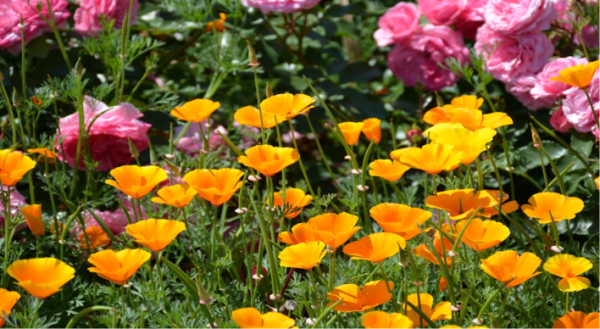
California Poppy
⦁ California poppy
Scientific name: Eschscholzia californica
California poppy is one plant that blooms very fast. It has some deep roots that grow up to 12 inches hence they mine the soil and soften it.
Also, it has some bright yellow flowers that will tell you if it’s going to rain as they will close up. It also has a lacy foliage that will attract insects to your garden.
⦁ Calendula
Scientific name: Calendula Officinalis
This is a great annual flower that you will fall in love with as soon as you pant it in your garden for the first time.
It has a cheerful daisy-like flower that’s yellow in color.
It grows to a height of 18-24 inches tall.
Also, it has a sticky sap that traps pests like the whiteflies and aphids.
In that case, it keeps them off from the nearby plants in your vegetable garden.
In addition to that, this plant attracts many pollinators and other beneficial insects like the ladybugs and the green lacewings. This flower could also be grown as a cover crop so that it holds the soil in place during the winter season.
⦁ German Chamomile
Scientific name: Matricaria chamomilla
The German Chamomile is a button dainty flower which comes with a lacy foliage that attracts the beneficial insects and pollinators.
These flowers can grow up to 12 inches meaning that it has really deep roots with a lot of nutrients.
Therefore, as soon as the season ends, you can cut the plant so that you allow these nutrient-rich matters to fertilize the soil.
⦁ Nasturtium
Scientific name: Tropaeolum majus
This is an annual flower that has some peppery flowers and leaves. In that case, it gives off that strong scent that repels off pests in your vegetable garden.
This flower has a dense and low growing habit as it grows 12-18 inches deep.
Therefore, this flower acts as a good living mulch as it acts as a good cover for the crops underneath. And as it dies back, it feds the soil of its nutrients.
It has some showy flowers that are great for a vegetable garden.
⦁ Sweet alyssum
Scientific name: Lobularia maritima
This is a popular flower that is grown on the landscape borders.
It is a low growing plant that has a very pleasant scent. It also comes in a variety of colors but the white flowers are the ones that attract the most insects.
More to that, this flower is just the best living mulch as it has some shallow roots that help to hold the soil to place.


